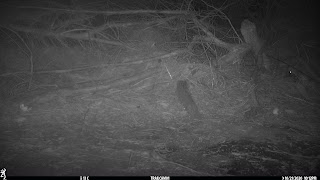As part of our ongoing project working on sound lures we are also looking at opportunities to use the technology involved in the project to engage with the students of our community and our community. In this instance on a local farm where we have started the final possum trial and deployment the farmer had another issue, the dissapearance of duck eggs belonging to some farm animals. While we were reconfiguring the possum sound lure we took the opportunity to use the cameras for tracking at the sound lure locations to solve the 'mystery' of the missing eggs. We also went through a process of identifying with the students what could be going on, what animals could be involved etc.
The ducks themselves were not attacked by the animals that were responsible for breaking of the eggs. Whatever it was, was leaving the ducks alone and targetting their eggs. The farmer placed some additional chicken eggs in the location where the ducks eggsThe images from the camera were able to identify two possible explanations. The first is shown in the night pictures from the area. A hedgehog can clearly be seen operating in the area. There is the possibility that it was responsible for the initial damage to the eggs followed by the hawk feasting on them.
The second stunning set of images catches the hawk that can be seen breaking the eggs including picking the eggs up in its beak and walking around. If this was the case it maybe that the hedgehog was incidental to the hawk which committed its act without any encouragement from the hedgehog.Clearly the date and timestamp of the trail camera shows that this occurred during the morning which the farmer was unaware of. In this instance we have not recorded any hawk activity in the prior year of experimenting with the sound lures - and in this instance the sound lures were not involved in the process.
However it was a fantastic opportunity to involve students in the learning process. To further our discussion about predators (for instance we had almost decided to discount stoats on the basis that whatever was taking the eggs was not attacking the ducks themselves which is something that we could expect to see if a stoat was responsible.
We would once again like to thank the local farmers who are assisting with our process and allowing our students to have such fantastic learning experiences.


No comments:
Post a Comment